B2B Net Promoter Score – Implement It With These 7 Steps
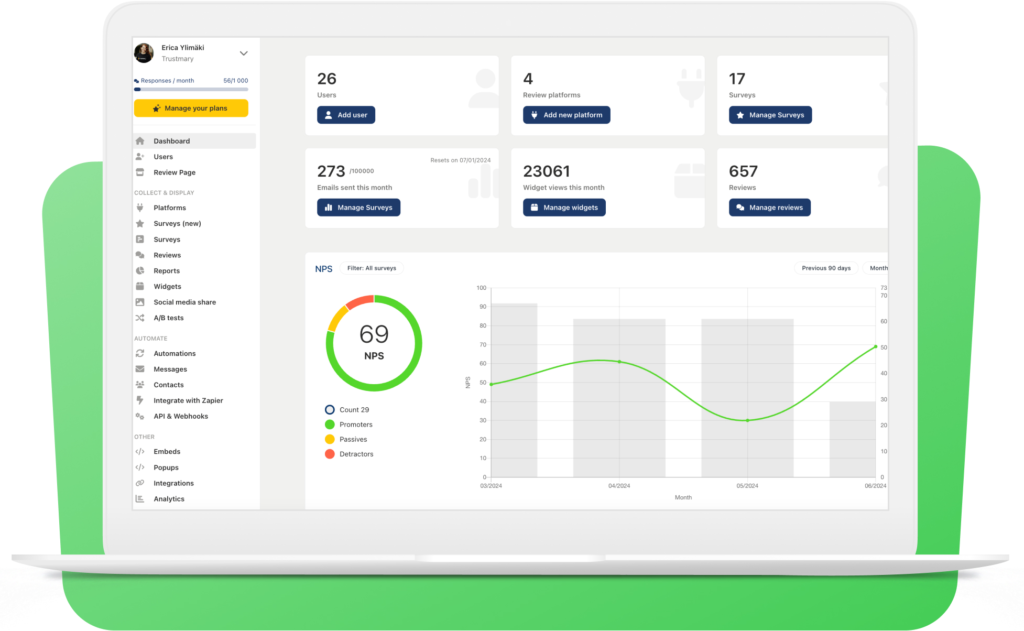
Ok. So everyone is talking about Net Promoter Score.
Your CEO, your industry peers, even your clients.
And everyone wants to know about NPS excellence:
“Isn’t NPS just for B2C companies? How can we make it work for our business?”
“How often should we be measuring our NPS score?”
“What are you doing with my feedback?”
Well, take a deep breath. It’s ok. We’ve got your back.
Let’s explore the world of B2B Net Promoter Score together.
We’ll cover everything from why and when to measure your NPS, plus 7 steps to implementing NPS in a B2B company.
Quick Steps to Start Measuring NPS
Looking for an NPS solution right at this moment? We got you.
- Register to Trustmary.
- Use the ready-made NPS template that also gets you testimonials from Promoters.
- Send NPS survey emails to customers.
That's it. Start now for free or read the rest of the guide.
What is Net Promoter Score?
Net Promoter Score (NPS) is a widely used business metric to measure customer loyalty.
Customers are asked if they would recommend the product, service or company, and the NPS score is calculated by subtracting the percentage of Detractors (those who wouldn’t recommend you) by the percentage of Promoters (those who would recommend you).
NPS questions are often followed up with a qualitative question to explore why the respondent gave the score in the first place.
You can explore the history of NPS, and how to measure it, in our Definitive Guide to NPS.
Why ALL B2B Companies Should Start Measuring NPS
Let me be straight with you.
Most of what you’ll read about NPS tends to have a B2C slant.
But, that doesn’t mean NPS isn’t equally as valuable to B2B companies.
Here are 5 reasons why:
The Power of WOM
Satisfied customers will spread the news about your brand.
They will tell their colleagues and peers about what a great job you’re doing. They’ll advocate your services at their next job, and even the one after that
And what’s more, WOM really works!
92% of B2B buyers are more likely to purchase after reading a trusted review.

Net Promoter Score gives you insight into exactly who your Promoters are.
Insights from Customer Feedback
Net Promoter Score is quite literally the voice of the customer.
Your Promoters recommend your brand for a reason, and the same goes from your Detractors.
The B2B feedback that you collect gives insight into what you’re doing well, but crucially, also where there’s room for improvement.
This NPS data can then be used to create actionable insights, guide your business strategy, and improve customer satisfaction.
Find out how you can harness Net Promoter Score (NPS) feedback by booking a meeting with the Trustmary team.
Correlation With Revenue Growth
Did you know that a good NPS score correlates closely with revenue growth?
Satisfied clients will generally spend more and have a higher customer lifetime value.
In fact, Promoters are 4.2 times more likely to buy again, 5.6 times more likely to forgive a company after a mistake and 7.2 times more likely to try a new offering compared with the Detractors.

And that’s not all.
Being an NPS leader in your industry can impact your bottom line - revenue grows by 1%, at every 7% rise of a brand’s NPS!
Wow!
Solid Benchmark Metric
While we’re on the subject of industry leaders, Net Promoter Score gives you a great benchmark which you can use to measure your progress.
Against yourself and against others in your industry.
Tracking results from regular NPS surveys helps you build a good picture of how your customer experience is progressing from one quarter to the next.
Comparing your results against an industry standard, not only shows how you’re doing against your competitors, but gives you an idea of how you can get ahead of the curve.
Stronger Client Relationships
B2B companies tend to have smaller client pools than B2C companies.
For example, a B2B company may have 20 accounts, whereas a B2C company of a similar revenue size may have 500,000 active users.
But in the B2B world, relationships with customers tend to run deeper, which translates to:
- Higher engagement with NPS surveys, and therefore a more accurate sample size
- Higher satisfaction levels, resulting in more favorable NPS scores
- Better quality feedback and suggestions to open ended questions
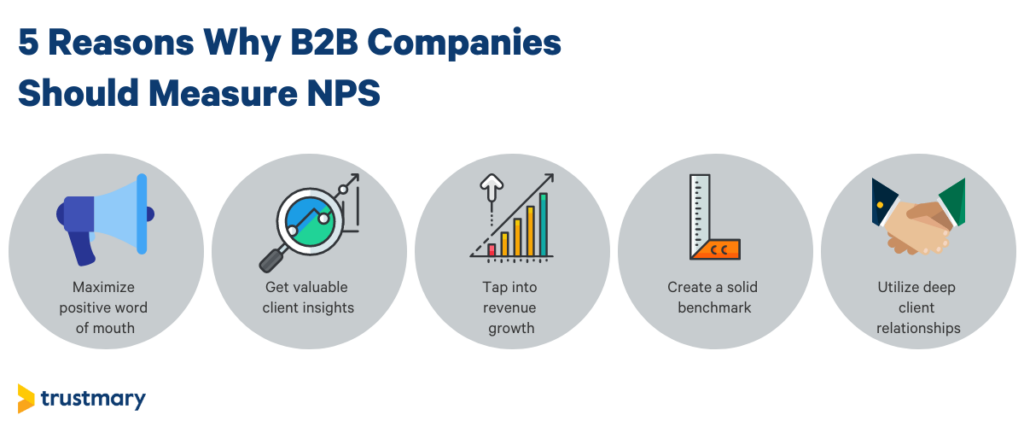
When to Measure NPS
We’ve established why you should be measuring Net Promoter Score. Now it’s time to look at when you should be measuring it.
Well, the answer actually depends on what you are measuring: your overall relationship, or satisfaction at a specific point in the customer journey?
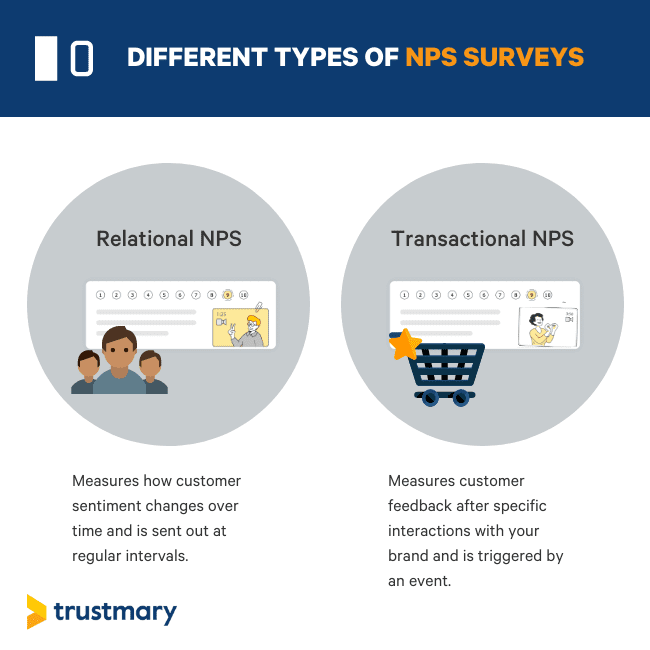
Relationship NPS
If a B2B company wants to know how loyal its clients are they can measure relationship NPS.
This is done by sending out a NPS survey at regular intervals to measure customer satisfaction. As the data builds over time, you start seeing a progressing picture of the company’s reputation.
So how often is ‘regular’?
Some might say once a year is enough, but leaving too long in between surveys comes with the risk of missing critical information about how your company is doing.
Say you send out a NPS survey in March, but in October you have an issue with your billing function which directly impacts on your client’s business. Do you really want to wait six months to find out that your client is very, very upset about it? Probably not.
We think that you should be sending out NPS surveys at least once a quarter.
This gives you enough time to implement feedback from the last survey, while being frequent enough to spot trends.

Transactional NPS
Transactional NPS measures customer feedback after specific interactions with a brand.
For example, when closing a deal, a salesperson may share a link to fill out a NPS survey, or a digital platform may ask if you’d recommend the service after you’ve used a new feature for the first time.
The event-based nature of transactional NPS means that it can be unbelievably useful in identifying the highs and lows of your customer journey - giving you hard numbers that you can work to improve from.
It can be automated so that it’s triggered by a specific action, or incorporated into client service processes, like the after-sales process.
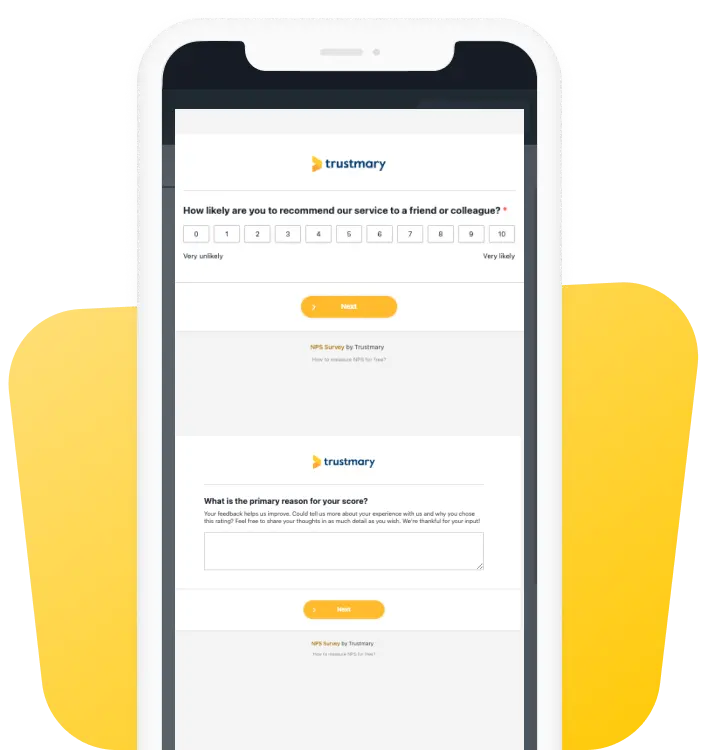
7 Steps to Implement NPS in a B2B Company
1. Set SMART Goals
Ask yourself this: what do you want to achieve from your Net Promoter Score program?
For some, finding out the pain points in the customer experience may be the top priority. For others, it may be to predict and prevent churn.
Establish whatever is important for your business and keep this in mind as you set Specific, Measurable, Attainable, Relevant and Timely (SMART) goals for your NPS program.
Your SMART goal can help set your strategy too.
For example, your business priority may be to increase contract renewals by 10% by the end of the year.
You may decide to measure relationship NPS on a quarterly basis, but also transactional NPS for those who are reaching the end of their contract to help predict who might not renew.
2. Get Buy-In
Whatever your strategy, you’re going to need buy-in from across the business.
In fact, I can’t stress this enough: NPS isn’t the sole responsibility of Marketing or Customer Success teams.
It’s a company-wide initiative.
Before you get started, you will want to ensure you have engaged and committed senior executives and departments, plus the right internal structures in place to make use of the information.
After all, what’s the point in finding out you’re delivering a killer service, or you have a major problem on your hands, if no one’s going to listen?
3. Automate Where You Can
NPS surveys are easy in theory, but can get very complicated, very fast - especially if you’re trying to target different customer segments, or measuring multiple touchpoints in the customer journey.
Luckily, there are a whole range of NPS software tools on the market that can make your life so much easier.
NPS software streamlines the whole process and makes collecting, analyzing and actioning customer feedback hassle-free. We explore 5 of the best tools in our handy guide.
And while you're automating your NPS campaigns, you should also automate how the feedback is shared across your business.
NPS ratings are best used with other metrics to paint a comprehensive picture of customer satisfaction (you can find out why here).

NPS software that can be easily integrated with other tools will help you connect the dots between your survey results and other areas of the business.
Book a meeting with the Trustmary team to find out how you can start easily designing and implementing NPS campaigns for your business.
4. Keep It Simple
It’s time to design and send out your survey, and here the key is to keep it really simple.
The point of a NPS survey is to be quick and easy to complete to maximize responses and get a true snapshot of customer satisfaction.
We get it - customer feedback is exciting, but fight the urge to ask too many questions. Trust us - two or three questions are plenty.
The second point here is about making it easy for your customer to respond.
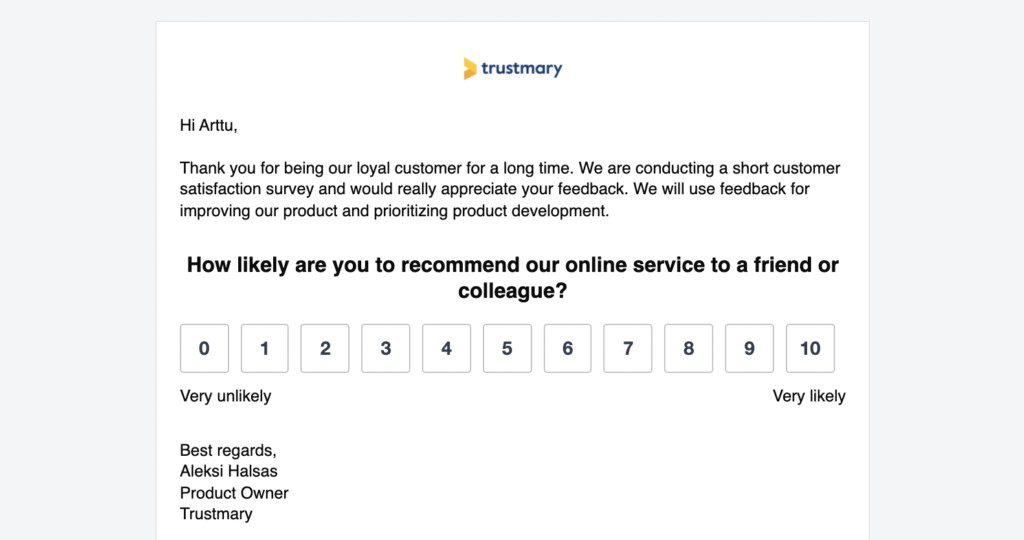
Whether you send out your survey via email, in-app pop ups, text or some other means, choose the right channel (and the right point in time) for your clients.
Our Definitive Guide to Net Promoter Score (NPS) explores this in more detail.
5. Act Fast
As the results start rolling in, you will start spotting trends in the data. The good stuff is, well, great but the negative reviews is where the real gold lies.
Understanding what your Detractors are thinking and feeling allows you to act.
If they hate something, fix it. If they don’t understand, communicate better.
And time is really of the essence here.
Acting fast on the feedback shows that you’ve been listening, and allows you to fix the problem before it turns into a bigger issue, like churn.
It also allows you to test the success of your actions when your next NPS survey comes around. The feedback will show if what you’re doing is really moving the customer satisfaction needle.
6. Follow Up
What’s a better way to show that you’ve heard your clients than acting fast? Telling them.
Your customers have taken time out of their day to provide feedback - the least you can do is thank them for their time.
But to go one step further - let them know about the changes you've made based on their feedback.
This is known as closing the loop.
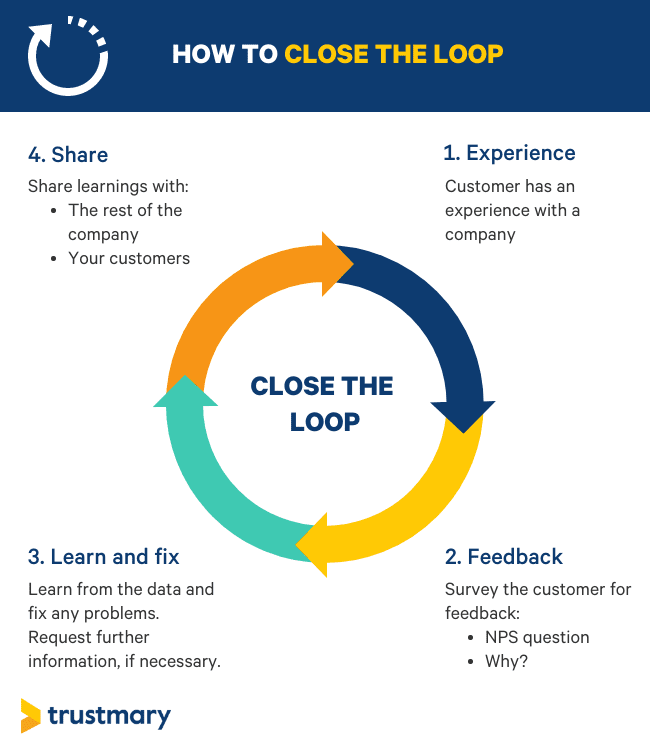
Reaching out to unhappy customers to keep them informed, or even involve them in the improvement process, has one unique benefit.
It can build customer loyalty and even turn Detractors into Promoters!
7. Share the Love
Once you’ve got your NPS score, it’s time to shout it from the rooftops.
Share the news internally
Align your business with the customer’s needs by letting everyone internally specific feedback and what you intend to do about it.
Use the data to guide decision-making across your business - create a roadmap of improvements that sets a clear path forward.
To accomplish this, you need to know how to present NPS results engagingly.
Create accountability by communicating specific roles for departments and individuals and how they can all contribute to improving customer experience.
As you conduct more surveys, share your progress too!
Share the news externally
Customers want to work with more authentic and transparent companies, even in the B2B space.
What better way to show transparency than to share your NPS score and some of the great feedback that you’ve received?
Capturing your Promoter’s feedback to use as social proof in your marketing materials is a great way to make use of all that love they have for your business.
Trustmary’s NPS tool makes it easy to turn positive feedback from your Promoters into testimonials for your website.
Book a meeting with the team to find out how.
Focus on Customer Relationships
Net Promoter Score is a great way to measure loyalty for all kinds of businesses, but especially for B2B companies.
NPS utilizes positive sentiment, maximizes those deeper relationships with your clients and gives you a solid benchmarking metric.
But it also provides invaluable insights to start basing decisions on to build a more customer-centric organization.
When and how you measure your NPS will depend on what you’re actually trying to measure which is why setting SMART Goals at the start of the program is important.
Getting buy-in from across the company is also critical so that all relevant departments are aligned to delivering a better customer experience.
There are some really great tools you can use to make the process of collecting and sharing feedback internally easier, as well as responding to your clients, fast.
Trustmary’s NPS tool not only streamlines this process for you, but also allows you to utilize positive feedback for marketing.
Book a meeting with the Trustmary team today to start building a successful B2B Net Promoter Score program for your business.
FAQ
Is NPS right for B2B companies?
Absolutely! There are many benefits for B2B companies who are tracking their Net Promoter Score:
- Invaluable insights from customer data
- Maximizing positive sentiment
- Opportunity for organic growth
- Creating a reliable benchmarking metric
- Utilizing strong client relationships
When should I measure NPS?
It really depends on what you are trying to measure. If you want to know overall sentiment towards your brand, product or service (relationship NPS), you should canvass opinions at least once a quarter to build up a progressive picture of customer satisfaction.
Measuring sentiment at specific points in your customer journey (transactional NPS) will be triggered every time a specific action or event occurs.
How can I start implementing a NPS program?
Start by setting SMART goals for what you want to achieve. You can then use this information to get buy-in from other teams and senior management.
You can also investigate NPS software to automate as much of the process as possible.
How do I run an NPS campaign?
Keep your survey to 3 questions, maximum, and make it easy for your clients to answer.
Once the data starts coming in, take action on the information so that you can address any problems.
Don’t forget to follow up with your clients to thank them for their time, but also to share the valuable learnings.
What should I do after the research?
If you are listening to your clients and learning from their feedback, then that’s half the battle.
Sharing insights internally helps everyone in your organization get on the same customer-centric page, and can help create accountability.
You can also utilize positive feedback from your Promoters in your marketing materials.
